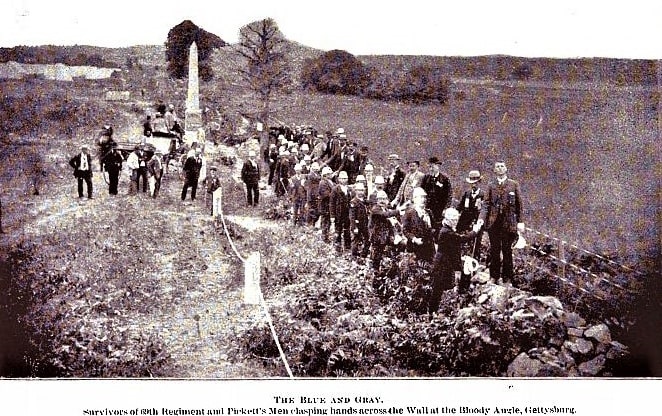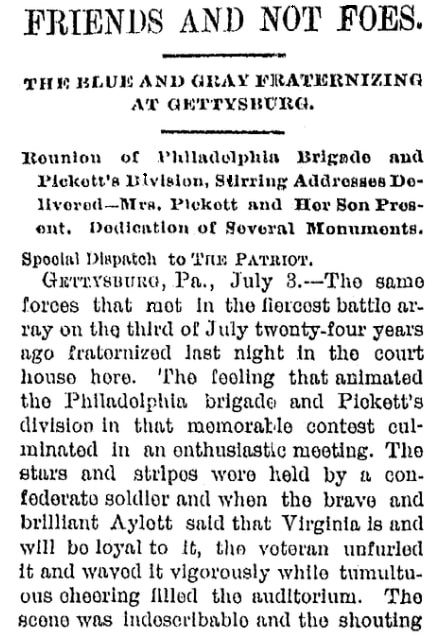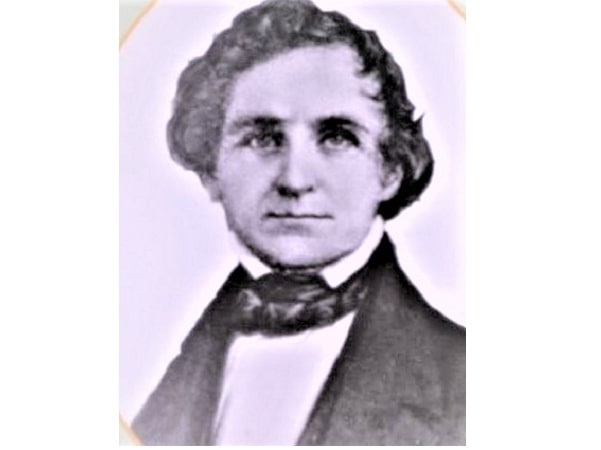Introduction: In this article, Melissa Davenport Berry continues her series on descendants of the Jamestown settlers, focusing on the lineage of William Roane Aylett (1833-1900). Melissa is a genealogist who has a blog, AnceStory Archives, and a Facebook group, New England Family Genealogy and History.
Confederate General Lewis Armistead to British Lieutenant Colonel Arthur Fremantle:
“Colonel Fremantle, it does not begin or end with my uncle, or myself. We are all sons of Virginia here… The colonel behind me… that’s Colonel William Aylett. Now, his great-grandfather was the Virginian, Patrick Henry. It was Patrick Henry who said to your King George III, ‘Give me liberty, or give me death’… We are all here, Colonel. You may tell them, when you return to your country, that all of Virginia was here on this day.”
—Gettysburg 1993 American war film about the Battle of Gettysburg in the American Civil War.
Today I continue with my “Jamestown Descendants: Who’s Who” series, focusing on the lineage of Colonel William Roane Aylett (1833-1900), a direct descendant of Captain John West – who served as the colonial governor of Virginia and a member of the House of Burgesses. The West line can be traced back to England’s infamous Boleyn family. (Read my English Royalty, Boleyn Lineage, and Jamestown Connections.)
The text quoted above is from a scene in the 1993 Gettysburg film shortly before Pickett’s Charge. General Armistead references William R. Aylett’s ancestor Patrick Henry, the fiery orator and staunch supporter of the American Revolution. He is one of America’s Founding Fathers, who served as the first and sixth post-colonial governor of Virginia.
Aylett was a colonel in the 53rd Virginia Infantry Regiment that fought at Gettysburg under General George Pickett. He was wounded that day in battle but assumed command of the brigade.
He would sustain another wound at Drewry’s Bluff. At Saylor’s Creek he was captured and made a prisoner of war by the Union Army until he was released on 25 July 1865.

In 1887, Union and Confederate veterans of the Battle of Gettysburg returned to the site for a reunion, as reported in the Patriot newspaper.

At the reunion, Aylett gave a moving speech to the crowd in which he denounced the Confederate flag. His sentiments to maintain a reunited country were shared with his kinsmen General Robert E. Lee.
According to this article, Col. Aylett said:
Not only do we receive and shall ever treasure the noble sentiments of Colonel McClure as the voice of Pennsylvania and her chief city, but also of those brave men who met us here 24 years ago with a valor that we could not overcome, and who meet us here tonight with a loving welcome so dear to us and to our people…
I utter it as the sentiment that comes welling up from every bosom of Virginia and the South, that the man who would kindle that feeling which filled our land with groans and tears and grief and mourning, with graves and suffering, is not only unworthy of the high title of American citizen but even of that of a human being, and should find no home or friends on earth or in heaven. There is not a true man at the South today but who feels as if he would like to stand at the tombs of Lincoln and Grant to plant a flower there and to water it with a manly tear. In the presence of a feeling like this, too sacred and deep for utterance, what matters it who shall keep the battle flags? They passed into your hands in brave and manly combat, untouched by dishonor, after a baptism in blood that made the gray jacket a mantle of glory, and we are as willing your people should keep them as ours. They are in the hands of our government, to whom our honor should be as dear as their own. Never again will our old battle flags wave in strife. They have gone down forever, but they went down in glory and in honor. They are dead, and we love and follow alone now the living flag, which floats from Key West to Behring Straits, from Bunker Hill to San Francisco.
After the war, Aylett returned home to set up a law firm and eventually became the commonwealth attorney in King William County, Virginia, as well as a Virginia state representative.
He also managed the family farm “Montville,” part of the Fairfield Plantation, which was a grant from the Crown to John Aylett, cavalier and immigrant, in 1658.
William Aylett married Alice Roane Brockenborough and reared several children, leaving many descendants.
Below is Aylett’s lineage, which can be traced back to the Plantagenets:
- William Aylett married Alice Roane Brockenborough
- Philip Aylett and Judith Page Waller
- Philip Aylett and Elizabeth Henry, daughter of Patrick Henry and Sarah Shelton
- William Aylett and Mary Macon, widow of Bartholomew Dandridge
- Philip Aylett and Martha West Dandridge
- William Dandridge and Unity West
- Nathaniel West and Martha Woodward, widow of Gideon Macon
- John West and Ursula “Unity” Croshaw
- John West and Ann (purported Lady Ann nee Percy, daughter of Sir George Percy)
- Sir Thomas West and Lady Ann Knollys
- Sir Francis Knollys and Lady Katherine Carey
- Sir William Carey and Lady Mary Boleyn
- Sir Thomas Boleyn and Lady Elizabeth Howard
I found an article in the Richmond Times-Dispatch on Aylett’s ancestors, the three West brothers who came to Jamestown.
This article reported:
The brothers were… Captain John West, who was governor from 1633 to 1637; Sir Thomas West, Third Lord de la Warr*, first resident governor, 1609-1618; and Captain Francis West, who was governor, 1627-1629. These brothers were sons of Sir Thomas West, Second Lord de la Warr, and Anne Knollys, his wife, the daughter of Sir Francis Knollys and his wife, Lady Catherine Cary [spelling variation]. Lady Catherine was daughter of Lady Mary Boleyn Cary, who was sister of Queen Anne, wife of Henry VIII.
About 1620 Captain John West came to Virginia, where he took an active part in the affairs of the colony. He was a member of the King’s Council from 1630 to 1659, the year of his death. For some time he was president of the council. Virginia’s West Point was named for him.
*The state of Delaware was named after Sir Thomas West, Third Lord de la Warr, who was one of the largest investors in the Virginia Company of London. He married Cecily Shirley, daughter of Sir Thomas Shirley and Ann Kempe. He also introduced John Rolfe to Pocahontas.
Stay tuned for more on the Aylett and allied family genealogies that include kinship to Martha Dandridge, wife of General George Washington, also a “Who’s Who” of Jamestown descendants.
Note: Just as an online collection of newspapers, such as GenealogyBank’s Historical Newspaper Archives, helped tell the stories of Jamestown descendant William Roane Aylett, they can tell you stories about your ancestors that can’t be found anywhere else. Come look today and see what you can discover!
Note on the header image: a portrait of William Roane Aylett (1833-1900). Courtesy of Trevor Caboor, a descendant of the Aylett family in Tennessee.
Explore over 330 years of newspapers and historical records. Discover your family story. Start a 7-Day Free Trial.
Related Articles:
